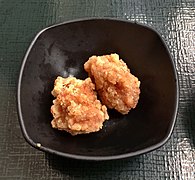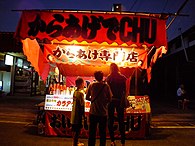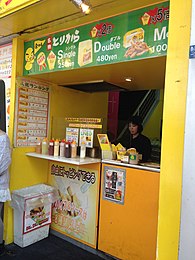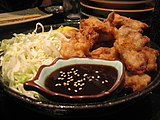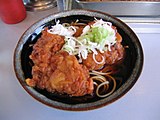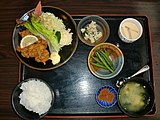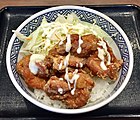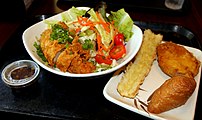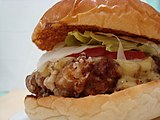Karaage
Karaage ( Japanese 唐 揚 (げ) A B , kana か ら あ げ , Chinese deep-frying, foreign deep-frying ' ) is one of the deep-fried dishes - agemono ( 揚 げ 物C , kana あ げ も Fr ' deep-fried ' ) - Japanese cuisine , alongside suage D and tempura (Tenpura). E Karaage is a simple Japanese dish that mostly consists of fried chicken - 鶏 の 唐 揚 げ - Tori no Karaage - but also vegetables, seafood , pork or beef - with sweet soy sauce .
Small pieces of meat are marinated in soy sauce, sake , ginger or garlic , covered with potato starch , flour or coarse breadcrumbs ( Panko , from the Asian market ) and then fried in hot oil. Ordinary seasonings from the kitchen are sufficient for seasoning, but nowadays one also likes to use industrially premixed seasoning powder for karaage. The finished dish is often garnished with a slice of lime or mayonnaise . In most cases, salad vegetables or cabbage vegetables are also cut into thin strips and served as a side dish with mayonnaise.
In addition to the term kaarage for dishes made from marinated deep-fried dishes, there is also the term Tatsutaage ( 竜 田 揚 げF , kana た つ た あ げ ) from the east of Osaka , which technically consists of the same ingredients. The name Tatsutaage originally comes from a local river called Tastutagawa ( 竜 田 川 ) near Ikoma , which is known for its colorful autumn foliage on the banks. The color of the ready-made deep-fried chicken kaarage and the autumn foliage on the river bank are the same color, which is how the name of the dish Tatsutaage is said to have originated.
The simple dish Karaage is a popular home cooking in Japan , which can be found both in restaurants as a main course or side dish and in Bentō boxes for out-of-home consumption. There is also karaage or fried chicken - フ ラ イ ド チ キ ン furaido · chikin B - as a snack, of course, in snacks , warm in vending machines and on stands at traditional Matsuri festivals. At the famous Karaage Matsuri festival in the city of Ōita , for example, over 60 stalls offer visitors various variations of this food every year.
comparison
Suage and tempura
In Japanese cuisine, suage ( 素 揚 げ , kana す あ げ , ' fried food without additives' ) are deep-fried foods in which food is fried without breading - such as breadcrumbs , wheat flour , eggs or anything else that is used as a batter to coat. Usually it is freshwater fish or vegetables such as eggplant , peppers or the like.
With tempura or tenpura ( 天 ぷ ら , kana て ん ぷ ら tenpura ), on the other hand, the breading of the fried food consists of a light coating of the dough made of finer rice or wheat flour and egg white. The breading in tempura is usually lighter, while in karaage the coating of the breading is a bit coarser and darker. With Kaarage, seasoning is usually done by marinating beforehand, while the taste of the dishes with tempura is baked “natural”.
- annotation
photos
- Chicken Karaage - 鶏 の 唐 揚 げ
Chicken Karaage G - 鶏 の 唐 揚 げ , 2007
Karaage Soba - そ ば の 唐 揚 げ , 2007
Karaage menu - か ら あ げ 定 食 , 2012
Karaage- don - 唐 揚 げ 丼 , 2019
Karaage- Yakisoba - やきそば唐揚げ , 2016
Bento with Chicken Karaage, 2007
- Various Karaage - 唐 揚 げ
Fried " octopus " - Tako no Karaage - タ コ の 唐 揚 げ
Deep-fried squid arms - Ikageso no Karaage - イカゲソの唐揚げ
Fried crawfish - Kawaebi Karaage - 川エビの唐揚げ
Fried Aalleber - Unagi no Kimo Karaage - 鰻の肝唐揚げ
Fried cartilage bone - Nankotsu Karaage - 軟骨からあげ
Web links
- Japan KARAAGE Association - JKA - 日本 唐 揚 協会 (Japanese)
- Line blog - JKA chairman Teppei Yasuhisa - や す ひ さ ・ て っ ぺ い (Japanese)
- Karaage: 30 Days of Japanese Food by Michael Turtle (English)
- Karaage recipe on bento-daisuki.de
- Karaage recipe on ryukoch.com
- Karaage recipe at www.uchigohan.de
Individual evidence
- ↑ 唐 揚 げ is the original term, 空 揚 げ and か ら 揚 げ are phonetic equivalents.
- ↑ a b Term "唐 揚 げ - karaage". In: tangorin.com. Retrieved June 20, 2020 (English, Japanese).
- ↑ a b Term "唐 揚 げ - karaage". In: Wadoku . Retrieved June 20, 2020 (English, Japanese).
- ^ Term "唐 - kara". In: tangorin.com. Retrieved June 20, 2020 (English, Japanese).
- ^ Term "空 - kara". In: tangorin.com. Retrieved June 20, 2020 (English, Japanese).
- ↑ a b c Agemono (fried food). In: 1mal1japan.de. December 23, 2019, accessed June 20, 2020 .
- ↑ a b Term agemono (揚 げ 物 ・ あ げ も の ・ 揚 げ も の ・ あ げ 物). In: tangorin.com. Retrieved August 6, 2020 (English, Japanese).
- ↑ a b Term Suage (素 揚 げ ・ す あ げ ・ 素 揚). In: tangorin.com. Retrieved August 6, 2020 (English, Japanese).
- ↑ a b Term Tenpura (天 ぷ ら ・ 天 麩 羅 ・ 天婦羅 ・ て ん ぷ ら ・ 天 プ ラ ・ て ん プ ラ ・ 天 麸 羅). In: tangorin.com. Retrieved August 6, 2020 (English, Japanese).
- ↑ Token: Ingredient: Okumoto Karaage Flour / Breader Mix. In: bento-lunch-blog.blogspot.com. January 28, 2018, accessed August 6, 2020 .
- ↑ Marc: CHICKEN KARAAGE (JAPANESE FRIED CHICKEN) - KARAAGE (か ら 揚 げ) VS. TATSUTAAGE (竜 田 揚 げ). In: norecipes.com. Retrieved August 6, 2020 (English, blog).
- ↑ a b Term factual days (竜 田 揚 げ ・ た つ た あ げ ・ 竜 田 揚 ・ 立 田 揚 げ ・ 立 田 揚). In: tangorin.com. Retrieved August 6, 2020 (English, Japanese).
- ↑ Karaage - Japan's cuisine loves to deep-fry ingredients. Over the centuries, several variants of deep-frying have been invented, Karaage is one of them. In: japan-lebensmittel.net. December 23, 2019, accessed June 20, 2020 .
- ↑ Alexandra M .: Tori Karaage - When things have to go fast. In: www.japaniac.de. July 25, 2017, accessed August 6, 2020 .
- ↑ Term “フ ラ イ ド ・ チ キ ン - furaido chiken”. In: tangorin.com. Retrieved August 6, 2020 .
- ↑ Term “フ ラ イ ド ・ チ キ ン - furaido chiken”. In: Wadoku . Retrieved August 6, 2020 (German, Japanese).
- ↑ Term “チ キ ン - chiken”. In: tangorin.com. Retrieved August 6, 2020 (English, Japanese).
- ↑ Term “チ キ ン - chiken”. In: Wadoku . Retrieved August 6, 2020 (German, Japanese).
- ↑ Term Sanzokuyaki (山賊 焼 き ・ 山賊 焼). In: Wadoku . Retrieved August 8, 2020 (German, Japanese).
